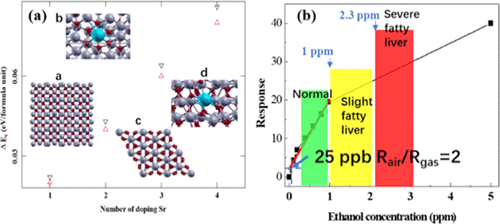当前位置:
X-MOL 学术
›
ACS Appl. Mater. Interfaces
›
论文详情
Our official English website, www.x-mol.net, welcomes your
feedback! (Note: you will need to create a separate account there.)
Sr-Doped Cubic In2O3/Rhombohedral In2O3 Homojunction Nanowires for Highly Sensitive and Selective Breath Ethanol Sensing: Experiment and DFT Simulation Studies.
ACS Applied Materials & Interfaces ( IF 8.3 ) Pub Date : 2019-12-20 , DOI: 10.1021/acsami.9b15928
Longfei Song,Kunpeng Dou,Rongrong Wang,Ping Leng,Linqu Luo,Yan Xi,Chao-Cheng Kaun,Ning Han,Fengyun Wang,Yunfa Chen
ACS Applied Materials & Interfaces ( IF 8.3 ) Pub Date : 2019-12-20 , DOI: 10.1021/acsami.9b15928
Longfei Song,Kunpeng Dou,Rongrong Wang,Ping Leng,Linqu Luo,Yan Xi,Chao-Cheng Kaun,Ning Han,Fengyun Wang,Yunfa Chen

|
In recent years, it is urgent and challenging to fabricate highly sensitive and selective gas sensors for breath analyses. In this work, Sr-doped cubic In2O3/rhombohedral In2O3 homojunction nanowires (NWs) are synthesized by one-step electrospun technology. The Sr doping alters the cubic phase of pure In2O3 into the rhombohedral phase, which is verified by the high-resolution transmittance electron microscopy, X-ray diffraction, and Raman spectroscopy, and is attributable to the low cohesive energy as calculated by the density functional theory (DFT). As a proof-of-concept of fatty liver biomarker sensing, ethanol sensors are fabricated using the electrospun In2O3 NWs. The results show that 8 wt % Sr-doped In2O3 shows the highest ethanol sensing performance with a high response of 21-1 ppm, a high selectivity over other interfering gases such as methanol, acetone, formaldehyde, toluene, xylene, and benzene, a high stability measured in 6 weeks, and also a high resistance to high humidity of 80%. The outstanding ethanol sensing performance is attributable to the enhanced ethanol adsorption by Sr doping as calculated by DFT, the stable rhombohedral phase and the preferred (104) facet exposure, and the formed homojunctions favoring the electron transfer. All these results show the effective structural modification of In2O3 by Sr doping, and also the great potency of the homojunction Sr-doped In2O3 NWs for highly sensitive, selective, and stable breath ethanol sensing.
中文翻译:

Sr掺杂的立方In2O3 /菱形In2O3同质结纳米线用于高灵敏度和选择性呼吸乙醇感测:实验和DFT模拟研究。
近年来,制造用于呼吸分析的高度灵敏和选择性的气体传感器是紧迫而富有挑战性的。在这项工作中,通过一步电纺技术合成了Sr掺杂的立方In2O3 /菱面In2O3同质结纳米线(NWs)。Sr掺杂将纯In2O3的立方相转变为菱面体相,这已通过高分辨率透射电子显微镜,X射线衍射和拉曼光谱进行了验证,并且归因于密度泛函计算的低内聚能理论(DFT)。作为脂肪肝生物标志物传感的概念证明,使用静电纺制的In2O3 NW制造了乙醇传感器。结果表明,8 wt%的Sr掺杂In2O3表现出最高的乙醇感测性能,具有21-1 ppm的高响应,对其他干扰气体(例如甲醇,丙酮,甲醛,甲苯,二甲苯和苯)具有很高的选择性,在6周内测得的稳定性很高,并且对高湿度的耐受性高达80%。出色的乙醇感测性能归因于DFT计算得出的Sr掺杂增强的乙醇吸附,稳定的菱面体相和优选的(104)小面暴露,以及形成的有利于电子转移的同质结。所有这些结果表明,通过Sr掺杂对In2O3进行了有效的结构修饰,并且同质结掺杂Sr的In2O3 NW对高效,选择性和稳定的呼吸乙醇感测具有巨大的潜力。出色的乙醇感测性能归因于DFT计算得出的Sr掺杂增强的乙醇吸附,稳定的菱面体相和优选的(104)小面暴露,以及形成的有利于电子转移的同质结。所有这些结果表明,通过Sr掺杂对In2O3进行了有效的结构修饰,并且同质结掺杂Sr的In2O3 NW对高效,选择性和稳定的呼吸乙醇感测具有巨大的潜力。出色的乙醇感测性能归因于DFT计算得出的Sr掺杂增强的乙醇吸附,稳定的菱面体相和优选的(104)小面暴露,以及形成的有利于电子转移的同质结。所有这些结果表明,通过Sr掺杂对In2O3进行了有效的结构修饰,并且同质结掺杂Sr的In2O3 NW对高效,选择性和稳定的呼吸乙醇感测具有巨大的潜力。
更新日期:2019-12-21
中文翻译:

Sr掺杂的立方In2O3 /菱形In2O3同质结纳米线用于高灵敏度和选择性呼吸乙醇感测:实验和DFT模拟研究。
近年来,制造用于呼吸分析的高度灵敏和选择性的气体传感器是紧迫而富有挑战性的。在这项工作中,通过一步电纺技术合成了Sr掺杂的立方In2O3 /菱面In2O3同质结纳米线(NWs)。Sr掺杂将纯In2O3的立方相转变为菱面体相,这已通过高分辨率透射电子显微镜,X射线衍射和拉曼光谱进行了验证,并且归因于密度泛函计算的低内聚能理论(DFT)。作为脂肪肝生物标志物传感的概念证明,使用静电纺制的In2O3 NW制造了乙醇传感器。结果表明,8 wt%的Sr掺杂In2O3表现出最高的乙醇感测性能,具有21-1 ppm的高响应,对其他干扰气体(例如甲醇,丙酮,甲醛,甲苯,二甲苯和苯)具有很高的选择性,在6周内测得的稳定性很高,并且对高湿度的耐受性高达80%。出色的乙醇感测性能归因于DFT计算得出的Sr掺杂增强的乙醇吸附,稳定的菱面体相和优选的(104)小面暴露,以及形成的有利于电子转移的同质结。所有这些结果表明,通过Sr掺杂对In2O3进行了有效的结构修饰,并且同质结掺杂Sr的In2O3 NW对高效,选择性和稳定的呼吸乙醇感测具有巨大的潜力。出色的乙醇感测性能归因于DFT计算得出的Sr掺杂增强的乙醇吸附,稳定的菱面体相和优选的(104)小面暴露,以及形成的有利于电子转移的同质结。所有这些结果表明,通过Sr掺杂对In2O3进行了有效的结构修饰,并且同质结掺杂Sr的In2O3 NW对高效,选择性和稳定的呼吸乙醇感测具有巨大的潜力。出色的乙醇感测性能归因于DFT计算得出的Sr掺杂增强的乙醇吸附,稳定的菱面体相和优选的(104)小面暴露,以及形成的有利于电子转移的同质结。所有这些结果表明,通过Sr掺杂对In2O3进行了有效的结构修饰,并且同质结掺杂Sr的In2O3 NW对高效,选择性和稳定的呼吸乙醇感测具有巨大的潜力。































 京公网安备 11010802027423号
京公网安备 11010802027423号